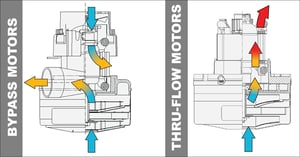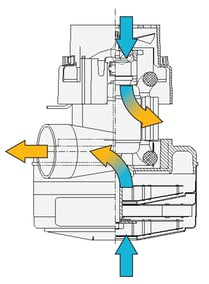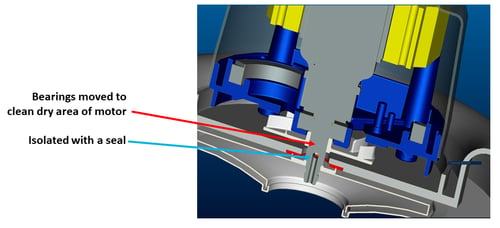 Universal motor-driven vacuums have been a staple in many industries for years. Whether it’s for vacuum cleaners, scrubbers, extractors, central vacuum systems, material transport, animal dryers, foggers or sprayers, these brushed motors are considered critical because of their versatility, durability, and dependability.
Universal motor-driven vacuums have been a staple in many industries for years. Whether it’s for vacuum cleaners, scrubbers, extractors, central vacuum systems, material transport, animal dryers, foggers or sprayers, these brushed motors are considered critical because of their versatility, durability, and dependability.
In this article, we’ll look at:
- What makes brushed vacuum motors unique
- Bypass vs thru-flow motors
- Considerations for application design
- Moisture protection
What are Brushed Universal Motors?
Brushed universal motors are based on a universal motor design, which uses a wound rotor and stator in series with one another. A commutator and carbon brushes serve as a high-speed mechanical switching system to serially distribute current to the rotor or armature coils and produce torque as they interact with the magnetic field produced by the stationary field coils.
In addition to the air-moving applications mentioned above, universal motors are commonly found in smaller, corded appliances, and have high speed and excellent starting capability. Their speed-torque characteristics make them ideal for driving fan loads. They speed up non-linearly as load decreases, and partly compensate for clogging filters in vacuum cleaners, delivering sustained performance. The workhorses of many applications, these motors are economical, having a high horsepower-per-pound ratio and are less costly than their brushless counterparts.
Design and Speed
When it comes to your application, you may have several goals to consider - vacuum or pressure, airflow, cost, life, and noise are just a few. Brushed motors are less expensive than their brushless counterparts. However, they do not provide the same features or life expectations. Brushes are consumable items.
While brushless motors do provide longer life, there is a cost for the magnets and electronics. Many brushless blowers also offer other technical features such as speed control, tach out signals, and programmability. Brushed motors are more basic but deliver a lot of performance relative to cost.
The output power of a motor is the product of torque and speed at a given point. Or:
P ~ T x N
By taking speeds up, torque requirements are reduced at the same power level. And torque is proportional to the copper and steel content of a motor. Fans are smaller and faster. So, smaller faster motors allow similar air performance (output power) in a smaller, lighter, and less expensive package.
When it comes to speed, brushed vacuum motors are fast. Historically, their standard speed was 15,000 to 25,000 RPM. This has been limited by component reliability. In recent years, however, material savvy design evolution has allowed the standard speed to increase to between 30,000 and 40,000 RPM in many models. Some designs routinely run 40,000 to 45,000 RPM, while others exceed 50,000 RPM.
Smaller and faster motors present challenges to rotating components. Therefore, manufacturers rose to the occasion.
- Bearing manufacturers improved their designs with new greases and glass-filled nylon ball cages.
- The commutator manufacturers improved their bar anchoring systems, developed internal reinforcing rings and better phenolics.
- Carbon brush manufacturers developed additives to their molded brushes to promote good filming at high speeds and reduce friction wear and arcing.
- AMETEK DFS has also stepped up its manufacturing game with improved processes to reliably operate at these speeds. Processes like commutator turning and fusing and armature impregnation are critical to long life.
Applications – Managing the Air Path
Vacuum blowers come in two basic styles, called thru-flow and bypass, referring to the relative paths of the working and cooling air. Each has advantages depending on the application.
 Thru-Flow Motors
Thru-Flow Motors
In thru-flow motors, the dry, filtered working air travels through the fan system and is discharged directly over the motor windings as it exits. The working air provides the cooling air for the motor.
For thru-flow motors:
- Working air = cooling air
- Restriction in working air restricts cooling ability of motor; often thermal protection is required
Thru-flow motors come in single- or two-stage configurations. Adding multiple fan stages allows pressure to build with each stage, delivering higher vacuum or pressure to the application. Single stage systems tend to provide better airflow at lower pressure/vacuum.
Your AMETEK DFS sales engineer can help you select the right motor for your needs.
Bypass Motors
 In bypass motors, the working air is independent from the cooling air. A separate fan is used to direct cooling air over the windings. Bypasses are used when it’s important to ensure the cooling air doesn’t mix with the vacuum or blower working air. Since the working air does not travel across the motor windings, bypass motors are a great option for scrubbers, carpet extraction, and other wet pickup applications because debris and moisture will not contact the windings directly. The working air should still be filtered. However, they are not designed to pump water.
In bypass motors, the working air is independent from the cooling air. A separate fan is used to direct cooling air over the windings. Bypasses are used when it’s important to ensure the cooling air doesn’t mix with the vacuum or blower working air. Since the working air does not travel across the motor windings, bypass motors are a great option for scrubbers, carpet extraction, and other wet pickup applications because debris and moisture will not contact the windings directly. The working air should still be filtered. However, they are not designed to pump water.
The OEM designer must take care when designing a bypass motor into their system that:
- The working and cooling air systems are separated from each other – they operate at different pressure levels and mixing them can disrupt the cooling flow.
- The cooling air path should be baffled so to separate the cooling inlet from the cooling exhaust. Failure to do so can cause recirculation with increased heating of the air and poor cooling performance.
Bypass motors come in peripheral and tangential discharge configurations and are available in single or multiple stages. Again, the purpose of the stages is to create more pressure or vacuum.
For bypass motors:
- Working air ≠ cooling air
- Separate cooling fan
- Separate paths; can safely handle moist working air (not liquids)
- Working air discharge can be tangential or peripheral
AMETEK DFS also offers bypass designs in various diameters from 4.2” to 9” in many vacuum and airflow ranges.
How to Determine the Ideal Design for Brushed Vacuum Motors
Since there are a variety of brushed vacuum motors available (currently over 1,400 unique AMETEK DFS models), there are questions you should ask to determine the ideal design for your application. Some of these questions include:
- What type of air will be picked up? Do you need a motor that has to pick up dry or moist air?
- What are the cooling requirements? Figure out whether external cooling will be necessary or if there is enough working air flow for cooling. Will some sort of thermal protection be required?
- What will be the operating point? Determine what kind of airflow rate, pressure or suction, current draw or input power will be necessary to do the intended job.
- What type of voltage? Understand the available operating voltage. Will you need an alternating current (AC) or direct current (DC) motor? Are you using line voltage or batteries? Or some other power supply? Universal motors can run on AC or DC, but they are sensitive to voltage, and must be designed for the operating voltage. What is your operating voltage level?
- What other features do you need? Does your application require thermal protection? Need serviceable brushes? Air discharge (tangential, peripheral or thru-flow)? Bearing protection? Specific life?
- Do you have regulatory agency requirements? Specific insulation class needs? Thermal protection for locked rotor in unattended installations? End-product agency requirements like blocked inlet protection?
By taking the time to think about the answers to these questions and collaborating with one of our experienced sales engineers, you can determine the right vacuum blower for your needs.
Protecting Bearings Against Moisture
At AMETEK DFS, our Lamb® vacuum motors take the worry out of protecting bearings from moisture damage. Our engineers have developed several solutions to protect bearings in moist applications. We use a patented air seal technology where a small fan creates a localized pressure in a chamber near the bearing. The pressure pushes moisture-laden air away from the bearings to keep them free of contaminants.
In addition, we use a PTFE washer on the shaft and right below the bearings on the pressure side. It works to create a physical sliding seal and keep moisture away rather than using pressure to blow it away. Some motor designs incorporate both air seal technology and PTFE washers.
Our 6.6” and 8.4” bypasses have been designed with a physical separation between the bearing and the fan system, and they offer the ultimate bearing protection.
We prove our designs by using a specialized life test to ensure optimal moisture protection. The test exposes the bearings to detergent suds and proves the effectiveness of the bearing protection. We also choose precision ball bearings with specialized greases and seals for additional protection.
AMETEK DFS Patented Air Seal Detail
 Selecting the right motor can be confusing. Fill out the form below for an engineering consultation.
Selecting the right motor can be confusing. Fill out the form below for an engineering consultation.





